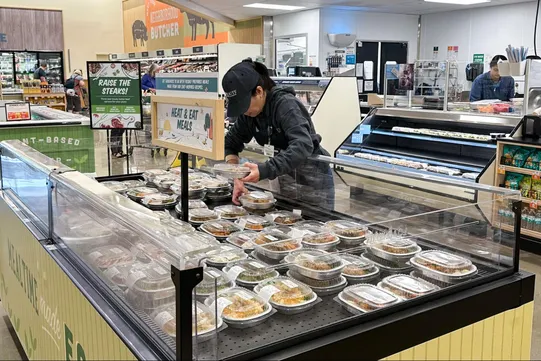Dive Brief:
- Craig Geiger, senior manager of Insights & Planning for the Kellogg Company, told the audience at the Shopper Insights & Retail Activation Conference that 39% of retailers report having a “brick and order” shopper demographic — or customers who place their order online and also shop inside the store.
- Although one in four households buy some groceries online, 51% of grocery sales are influenced by digital and that number will increase. Of the consumers who shop online, 58% use more than one service to do so, and 64% said they would switch to an online service that provided a better experience.
- Customers who shop online are driven to do so because they said it provides access to more product information and is a “stress-free” experience.
Dive Insight:
As shopping behaviors continue to evolve past a one-size-fits all approach, grocers will have to figure out how to balance online and in-store experiences to meet consumers’ “brick and order” demands. Grocers continue to have a big incentive to draw customers in store, where most impulse purchases happen. According to Euromonitor, nearly 70% of in-store snack purchases are unplanned.
But they also have an incentive to capture the growing digital crowd, as online shopping is projected to increase at 10 times the rate of in-store sales throughout the next five years.
The challenge will be to seamlessly marry the two and drive shoppers to do both. Innovative retailers are using e-commerce to deepen their engagement with existing shoppers. Hy-Vee, for example, offers recipes and assorted promotions alongside its Aisles Online shopping platform, while retailers like Food Lion have rolled out new mobile apps that help bridge the gap between the online and store experience.
Perhaps the biggest opportunity for retailers is in capturing shoppers who order online and then pick up their purchases at the store. For these “brick and order” shoppers, grocers could leverage beacon technology to push out a timely, in-store promotion while they’re on site, encouraging a quick pop in. Geiger calls this a basket plus: “If your product is in an impulse category, you may still be in the basket for an online shopper.”
Grocers can balance their brick-and-mortar and online channels by offering free shipping and by gaining trust through marketing the freshness of products that are delivered — two barriers to online shopping. They can also offer incentives for one or the other, like an online coupon printed on an in-store receipt, for example. Additionally, customers like the availability of information online, so stores can bridge that gap by providing this type of content — reviews or ratings, for example — in store.
A majority of online shoppers are not committed to their online service or their primary grocer, so a big opportunity exists for retailers to create loyalty here. Customers are driven online through coupons, curiosity and convenience. They also want free samples and exposure to new products in store. By using brick-and-mortar locations and online platforms to make shopping easier and more seamless overall, grocers can better differentiate themselves in a crowded category and better appeal to the new “brick and order” consumers.










